An Integrated Remote Sensing and Near-Surface Geophysical Approach to Detect and Characterize Active and Capable Faults in the Urban Area of Florence (Italy)
Abstract
1. Introduction
Seismotectonic Setting
- (A).
- Firenze–Pistoia Basin Synthem (Upper Pliocene–Lower Pleistocene): This is the oldest and thickest sedimentary unit in the basin, composed of fine-grained fluvio-lacustrine sediments interfingered with alluvial fan deposits along the basin margins. It reaches its maximum thickness, over 500 m, near the master fault, particularly in front of Prato and Sesto Fiorentino, and thins progressively toward the southwestern edge of the basin [15,16]. In the Florence sub-basin, its thickness varies, reaching up to 120 m near the Fiesole Fault [14,21].
- (B).
- Florence Synthem (Middle–Upper Pleistocene, “Ancient deposits”): This unit consists of fluvial deposits from the paleo-Arno River and its tributaries, with a thickness that varies and reaches a minimum of approximately 20 m over the city horst. Its deposition was influenced by tectonic uplift of the Florence sub-basin, which led to the formation of a broad alluvial fan northwest of the Scandicci Fault. The fan terminates in onlap against the fault escarpment [14,21,22].
- (C).
- Arno Synthem (Holocene, “Recent deposits”): Representing the final stage of basin infill, this unit comprises fluvial and alluvial sediments, mainly gravel and sand lenses. In the Florence sub-basin, it lies unconformably on the substrate with a thickness of about 15–20 m. Elsewhere in the basin, it overlies older sediments and varies in thickness from a few meters up to 20–30 m [14,21].
2. Materials and Methods
3. Results
3.1. The Firenze-Prato Fault
Fiesole Fault
- Seismic profile SL1
- Seismic profile SL2
- Geoelectric tomographic profile ERT4
3.2. SW-NE Oriented Structures
3.2.1. Peretola Fault
3.2.2. Scandicci Fault
- Tectonic geomorphology along the Scandicci fault
- Geophysical investigations
- Careggi area
- Banks of the Arno River
- Scandicci area
3.2.3. Maiano Fault
4. Discussion
5. Conclusions
Supplementary Materials
Author Contributions
Funding
Data Availability Statement
Acknowledgments
Conflicts of Interest
References
- Boccaletti, M.; Corti, G.; Gasperini, P.; Piccardi, L.; Vannucci, G.; Clemente, S. Active tectonics and seismic zonation of the urban area of Florence, Italy. Pure Appl. Geophys. 2001, 158, 2313–2332. [Google Scholar] [CrossRef]
- Database of Individual Seismogenic Sources (DISS). Version 3.3.0: A Compilation of Potential Sources for Earthquakes Larger than M 5.5 in Italy and Surrounding Areas; Istituto Nazionale di Geofisica e Vulcanologia (INGV): Rome, Italy. [CrossRef]
- ITHACA (Italy Hazard from Capable Faulting), A Database of Active Capable Faults of the Italian Territory. Version December 2019. ISPRA Geological Survey of Italy. Available online: https://sgi.isprambiente.it/ithacaweb/Default.aspx# (accessed on 12 December 2024).
- Ambrosetti, P.; Bosi, C.; Carraro, F.; Ciaranfi, N.; Panizza, M.; Papani, G.; Vezzani, L.; Bartolini, C.; Zanferrari, A. Neotectonic Map of Italy. Progetto Finalizzato Geodinamica, Scale 1:500.000. Quad. Ric. Sci. CNR 1987, 4, 1–6. [Google Scholar]
- Pondrelli, S. European-Mediterranean Regional Centroid-Moment Tensors Catalog (RCMT) [Data Set]; Istituto Nazionale di Geofisica e Vulcanologia (INGV): Rome, Italy, 2002. [Google Scholar] [CrossRef]
- Rovida, A.; Locati, M.; Camassi, R.; Lolli, B.; Gasperini, P. The Italian earthquake catalogue CPTI15. Bull. Earthq. Eng. 2020, 18, 2953–2984. [Google Scholar] [CrossRef]
- Rovida, A.; Locati, M.; Camassi, R.; Lolli, B.; Gasperini, P.; Antonucci, A. Catalogo Parametrico dei Terremoti Italiani (CPTI15), Versione 4.0 [Data Set]; Istituto Nazionale di Geofisica e Vulcanologia (INGV): Rome, Italy, 2022. [Google Scholar] [CrossRef]
- Conti, P.; Cornamusini, G.; Carmignani, L.; Pirro, A.; Pizziolo, M.; Daniele, G.; Lavorini, G.; Motti, A.; Natali, N.; Bettucci, C. Geological Map of the Northern Apennines (Emilia-Romagna, Marche, Tuscany, Umbria), Scale 1:250.000, 2 Sheets; Servizio Geologico, Sismico e dei Suoli, Regione Emilia-Romagna: Bologna, Italy, 2019. [Google Scholar]
- Regione Toscana. Geoscopio. Cartoteca. Geological Map Scale 1:10,000. Available online: https://www502.regione.toscana.it/geoscopio/cartoteca.html (accessed on 30 November 2024).
- Conedera, C.; Ercoli, A. Elementi geomorfologici della Piana di Firenze dedotti dalla fotointerpretazione. L’ Universo 1973, 53, 255–262. [Google Scholar]
- Dainelli, G. Il bacino di Firenze e il suo antico lago. In Mélange de Géographie; Mariano Ricei Ed.: Florence, Italy, 1936; 13p. [Google Scholar]
- Azzaroli, A.; Cita, M.B. Geologia Stratigrafica, 3rd ed.; Cisalpino Goliardica Ed.: Milan, Italy, 1967; 406p. [Google Scholar]
- Merla, G.; Bortolotti, V. Note Illustrative Della Carta Geologica d’Italia. Foglio 106, Firenze; Min. Ind. Comm. e Art.: Rome, Italy, 1967; 61p. [Google Scholar]
- Briganti, R.; Ciufegni, S.; Coli, M.; Polimeni, S.; Pranzini, G. Plio-Quaternary Evolution of the Firenze Area. Boll. Soc. Geol. Ital. 2003, 122, 435–445. Available online: https://pubs.geoscienceworld.org/sgi/italianjgeo/article/122/3/435/74862/Underground-Florence-Plio-Quaternary-geological (accessed on 12 December 2024).
- Capecchi, F.; Guazzone, G.; Pranzini, G. Il bacino lacustre di Firenze-Prato-Pistoia. Geologia del sottosuolo e ricostruzione evolutiva. Boll. Soc. Geol. Ital. 1975, 94, 637–660. [Google Scholar]
- Capecchi, F.; Guazzone, G.; Pranzini, G. Ricerche geologiche ed idrogeologiche nel sottosuolo della pianura di Firenze. Boll. Soc. Geol. Ital. 1975, 94, 661–692. [Google Scholar]
- Elter, P.; Giglia, G.; Tongiorgi, M.; Trevisan, L. Tensional and compressional areas in the recent (Tortonian to Present) evolution of the Northern Apennines. Boll. Geof. Teor. Appl. 1975, 65, 3–18. [Google Scholar]
- Boccaletti, M.; Coli, M.; Eva, G.; Ferrari, G.; Giglia, G.; Lazzarotto, A.; Merlanti, F.; Nicolich, H.R.; Papani, G.; Postpischl, D. Considerations on the seismotectonics of the northern Apennines. Tectonophysics 1985, 117, 7–38. [Google Scholar] [CrossRef]
- Piccardi, L.; Sani, F.; Bonini, M.; Boccaletti, M.; Moratti, G.; Gualtierotti, A. Deformazioni Quaternarie nell’Appennino centro-settentrionale: Evidenze ed implicazioni. Alp. Mediterr. Quat. 1997, 10, 273–280. [Google Scholar]
- Giannini, L.M.; Varone, C.; Esposito, C.; Scarascia Mugnozza, G.; Schilirò, L. The potential of spatial statistics for the reconstruction of a subsoil model: A case study for the Firenze-Prato-Pistoia Basin, Central Italy. J. Appl. Geophys. 2021, 194, 104466. [Google Scholar] [CrossRef]
- Coli, M.; Rubellini, P. Geological anamnesis of the Florence area, Italy. Z. Dtsch. Ges. Geowiss. 2013, 164, 581–589. [Google Scholar] [CrossRef]
- Coli, M. Inquadramento geologico e geomorfologico. In La Microzonazione Sismica e le Analisi Delle Condizioni Limite per L’emergenza del Comune di Firenze; Coli, M., Ripepe, M., Lacanna, G., Iandelli, N., De Stefano, M., Tanganelli, M., Paoletti, B., Baglione, M., D’Intinosante, V., Giomarelli, D., et al., Eds.; Regione Toscana, Direzione Ambiente ed Energia, Settore Sismica, Comune di Firenze, Università Degli Studi di Firenze: Florence, Italy, 2022; pp. 27–42. [Google Scholar]
- Abbate, E.; Sagri, M. Development of the Northern Apennines Eugeosinclinal sequence. Sediment. Geol. 1970, 4, 203–647. [Google Scholar]
- Boccaletti, M.; Coli, M. (Eds.) Carta Geologico Strutturale Dell’appennino Settentrionale, Scala 1:250.000; CNR, Progetto Finalizzato Geodinamica: Florence, Italy, 1982; 4p. [Google Scholar]
- Abbate, E.; Castellucci, P.; Ferrini, G.L.; Pandeli, E. I dintorni di Firenze. In Appennino Tosco-Emiliano; Bortolotti, V., Ed.; Guide Geologiche Regionali 1990, n. 4; Società Geologica Italiana: Rome, Italy; 329p.
- Nirta, G.; Vittori, E.; Blumetti, A.M.; Di Manna, P.; Benvenuti, M.; Montanari, D.; Perini, M.; Fiera, F.; Moratti, G.; Baglione, M.; et al. Geomorphological and paleoseismological evidence of capable faulting in the Northern Apennines (Italy): Insights into active tectonics and seismic hazard of the Lunigiana basin. Geomorphology 2021, 374, 107486. [Google Scholar] [CrossRef]
- Guidoboni, E.; Ferrari, G.; Mariotti, D.; Comastri, A.; Tarabusi, G.; Sgattoni, G.; Valensise, G. CFTI5Med, Catalogo dei Forti Terremoti in Italia (461 a.C.-1997) e Nell’area Mediterranea (760 a.C.-1500); Istituto Nazionale di Geofisica e Vulcanologia (INGV): Rome, Italy, 2018. [Google Scholar] [CrossRef]
- Guidoboni, E.; Ferrari, G.; Tarabusi, G.; Sgattoni, G.; Comastri, A.; Mariotti, D.; Ciuccarelli, C.; Bianchi, M.G.; Valensise, G. CFTI5Med, the new release of the catalogue of strong earthquakes in Italy and in the Mediterranean area. Sci. Data 2019, 6, 80. [Google Scholar] [CrossRef] [PubMed]
- Locati, M.; Camassi, R.; Rovida, A.; Ercolani, E.; Bernardini, F.; Castelli, V.; Caracciolo, C.H.; Tertulliani, A.; Rossi, A.; Azzaro, R.; et al. Database Macrosismico Italiano (DBMI15), Versione 4.0 [Data Set]; Istituto Nazionale di Geofisica e Vulcanologia (INGV): Rome, Italy, 2022. [Google Scholar] [CrossRef]
- Castelli, V.; Stucchi, M.; Moroni, A.; Monachesi, G. (Eds.) Revisione dei Principali Terremoti D’interesse per il Territorio Toscano Vol. 1: Dall’anno 1000 al 1731; Gruppo Naz. per la Dif. dai Terremoti, Rapporto Interno, Milano; Consiglio Nazionale delle Ricerche: Rome, Italy, 1996; pp. 6–7. [Google Scholar]
- Commissione Tecnica per la Microzonazione Sismica (Technical Committee for Microzonation), Microzonazione Sismica—Linee Guida per la Gestione del Territorio in Aree Interessate da Faglie Attive e Capaci (FAC), Versione 1.0. Conferenza Delle. Regioni e Delle Province Autonome—Dip. Protezione Civile, Roma, 2015, 66p. (In Italian). Available online: https://www.protezionecivile.gov.it/it/pubblicazione/microzonazione-sismica--linee-guida-per-la-gestione-del-territorio-in-aree-interessate-da-faglie-attive-e-capaci--fac-/ (accessed on 22 April 2025).
- IAEA (International Atomic Energy Agency). Seismic Hazards in Site Evaluation for Nuclear Installations; Specific Safety Guide. In IAEA Safety Standards Series, No. SSG-9 (Rev. 1); International Atomic Energy Agency: Vienna, Austria, 2022; 78p, Available online: https://www-pub.iaea.org/MTCD/Publications/PDF/PUB1950_web.pdf (accessed on 8 November 2024).
- Drahor, M.; Berge, M.A. Integrated geophysical investigations in a fault zone located on southwestern part of İzmir city, Western Anatolia, Turkey. J. Appl. Geophys. 2017, 136, 114–133. [Google Scholar] [CrossRef]
- Gabàs, A.; Macau, A.; Benjumea, B.; Bellmunt, F.; Figueras, S.; Vilà, M. Combination of geophysical methods to support urban geological mapping. Surv. Geophys. 2014, 35, 983–1002. [Google Scholar] [CrossRef]
- Galli, P.; Giocoli, A.; Peronace, E. Integrated near surface geophysics across the active Mount Marzano fault system (Southern Italy): Seismogenic hints. Int. J. Earth Sci. 2014, 103, 315–325. [Google Scholar] [CrossRef]
- Liberty, L.; Hemphill-Haley, M.A.; Madin, I.P. The Portland Hills Fault: Uncovering a hidden fault in Portland, Oregon using high-resolution geophysical methods. Tectonophysics 2003, 368, 89–103. [Google Scholar] [CrossRef]
- Villani, F.; Pucci, S.; Civico, R.; De Martini, P.M.; Nicolosi, I.; Caracciolo, F.D.; Carluccio, R.; Di Giulio, G.; Vassallo, M.; Smedile, A.; et al. Imaging the structural style of an active normal fault through multidisciplinary geophysical investigation: A case study from the mw 6.1, 2009 l’Aquila earthquake region (Central Italy). Geophys. J. Int. 2015, 200, 1676–1691. [Google Scholar] [CrossRef][Green Version]
- Wang, Z.; Cai, X.; Yan, J.; Wang, J.; Liu, Y.; Zhang, L. Using the integrated geophysical methods detecting active faults: A case study in Beijing, China. J. Appl. Geophys. 2017, 156, 1–92. [Google Scholar] [CrossRef]
- Bartolini, C.; Pranzini, G. Plio-Quaternary evolution of the Arno basin drainage. Z. Geomorphol. 1981, 40, 77–91. [Google Scholar]
- Gradstein, F.M.; Ogg, J.G.; Schmitz, M.D.; Ogg, G.M. (Eds.) The Geologic Time Scale 2020; Elsevier: Amsterdam, The Netherlands, 2020. [Google Scholar] [CrossRef]
- Coli, M.; Agili, F.; Pini, G.; Coli, N. Firenze: Il suo impatto sull’evoluzione geomorfica dell’area. Alp. Mediterr. Quat. 2004, 17, 195–211. [Google Scholar]
- Wells, D.L.; Coppersmith, K.J. New empirical relationships among magnitude, rupture length, rupture width, rupture area, and surface displacement. Bull. Seismol. Soc. Am. 1994, 84, 974–1002. [Google Scholar] [CrossRef]
- Mirabella, F.; Braun, T.; Brogi, A.; Capezzuoli, E. Pliocene–Quaternary seismogenic faults in the inner Northern Apennines (Valdelsa Basin, southern Tuscany) and their role in controlling the local seismicity. Geol. Mag. 2022, 159, 853–872. [Google Scholar] [CrossRef]
- Mariucci, M.T.; Montone, P. Database of Italian present-day stress indicators, IPSI 1.4. Sci. Data 2020, 7, 298. Available online: https://ipsi.rm.ingv.it/ (accessed on 22 April 2025). [CrossRef]
- McKenzie, D. Active tectonics of the Mediterranean region. Geophys. J. Int. 1972, 30, 109–185. [Google Scholar] [CrossRef]
- Boccaletti, M.; Conedera, C.; Dainelli, P.; Gocev, P. The recent (Neogene-Quaternary) regmatic system of the Western Mediterranean region. J. Petrol. Geol. 1982, 5, 31–49. [Google Scholar] [CrossRef]
- Tapponnier, P. Évolution tectonique du système alpin en Méditerranée: Poinçonnement et écrasement rigide-plastique. Bull. Soc. Géol. Fr. 1977, 7, 437–460. [Google Scholar] [CrossRef]
- Mantovani, E.; Albarello, D.; Babbucci, D.; Tamburelli, C. Evolution of the Tyrrhenian basin and surrounding regions as a result of the Africa-Eurasia convergence. J. Geodynam. 1996, 21, 35–72. [Google Scholar] [CrossRef]
- Sani, F.; Bonini, M.; Piccardi, L.; Vannucci, G.; Delle Donne, D.; Benvenuti, M.; Moratti, G.; Corti, G.; Montanari, D.; Sedda, L.; et al. Late Pliocene-Quaternary evolution of outermost hinterland basins of the Northern Apennines (Italy), and their relevance to active tectonics. Tectonophysics 2009, 476, 336–356. [Google Scholar] [CrossRef]
- Elter, F.M.; Elter, P.; Eva, C.; Eva, E.; Kraus, R.K.; Padovano, M.; Solarino, S. Strike-slip geometry inferred from the seismicity of the Northern-Central Apennines (Italy). J. Geodyn. 2011, 52, 379–388. [Google Scholar] [CrossRef]
- Delle Donne, D.; Piccardi, L.; Odum, J.K.; Stephenson, W.J.; Williams, R.A. High-resolution shallow reflection seismic image and surface evidence of the Upper Tiber Basin active faults (Northern Apennines, Italy). Boll. Soc. Geol. Ital. 2007, 126, 323–331. [Google Scholar]
- Benvenuti, M.; Bonini, M.; Moroni, A. Tectonic control on the Late Quaternary hydrography of the Upper Tiber Basin (Northern Apennines, Italy). Geomorphology 2016, 269, 85–103. [Google Scholar] [CrossRef]
- Piccardi, L.; Gaudemer, Y.; Tapponnier, P.; Boccaletti, M. Active oblique extension in the central Apennines (Italy): Evidence from the Fucino basin. Geophys. J. Int. 1999, 139, 499–530. [Google Scholar] [CrossRef]

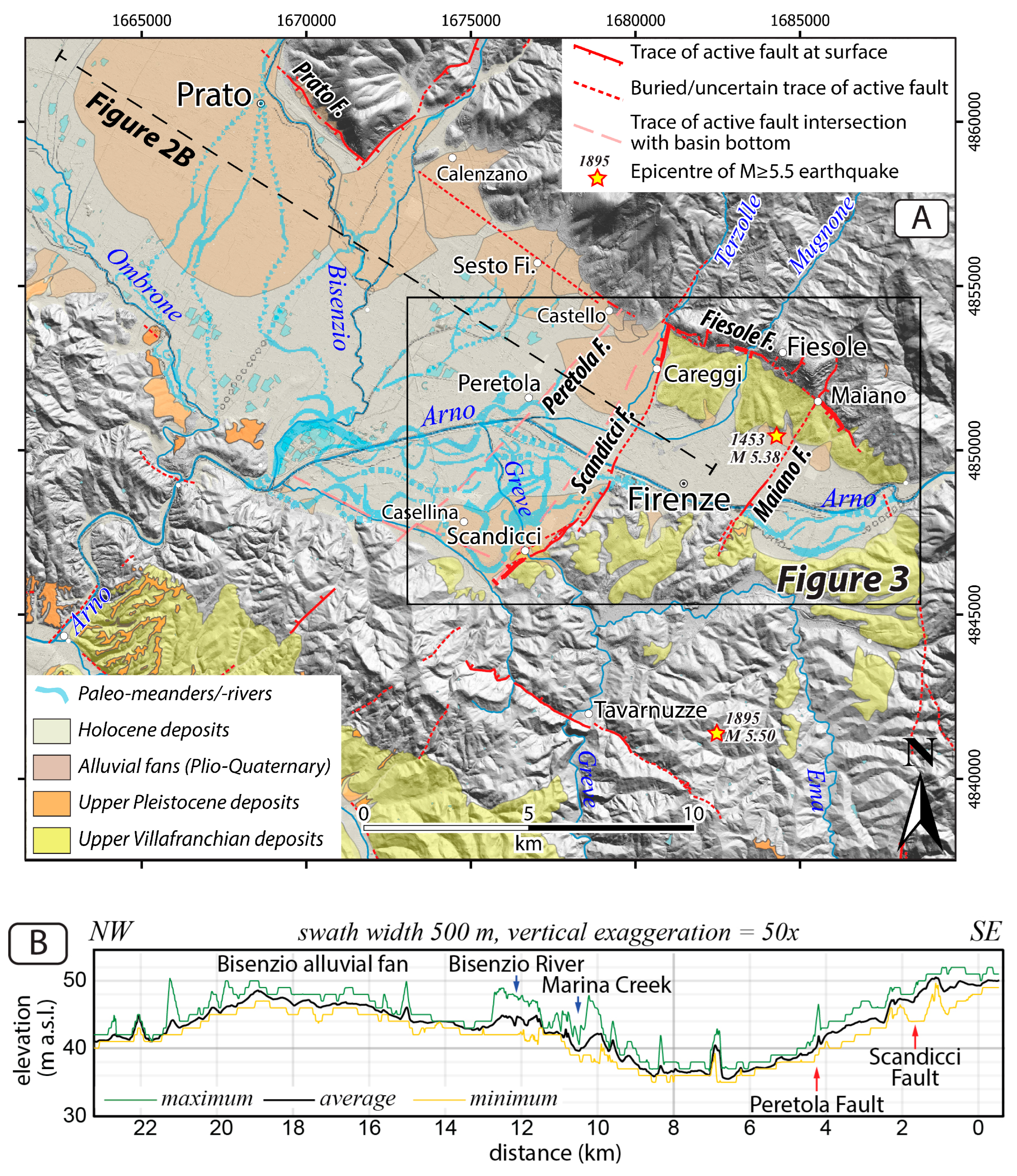
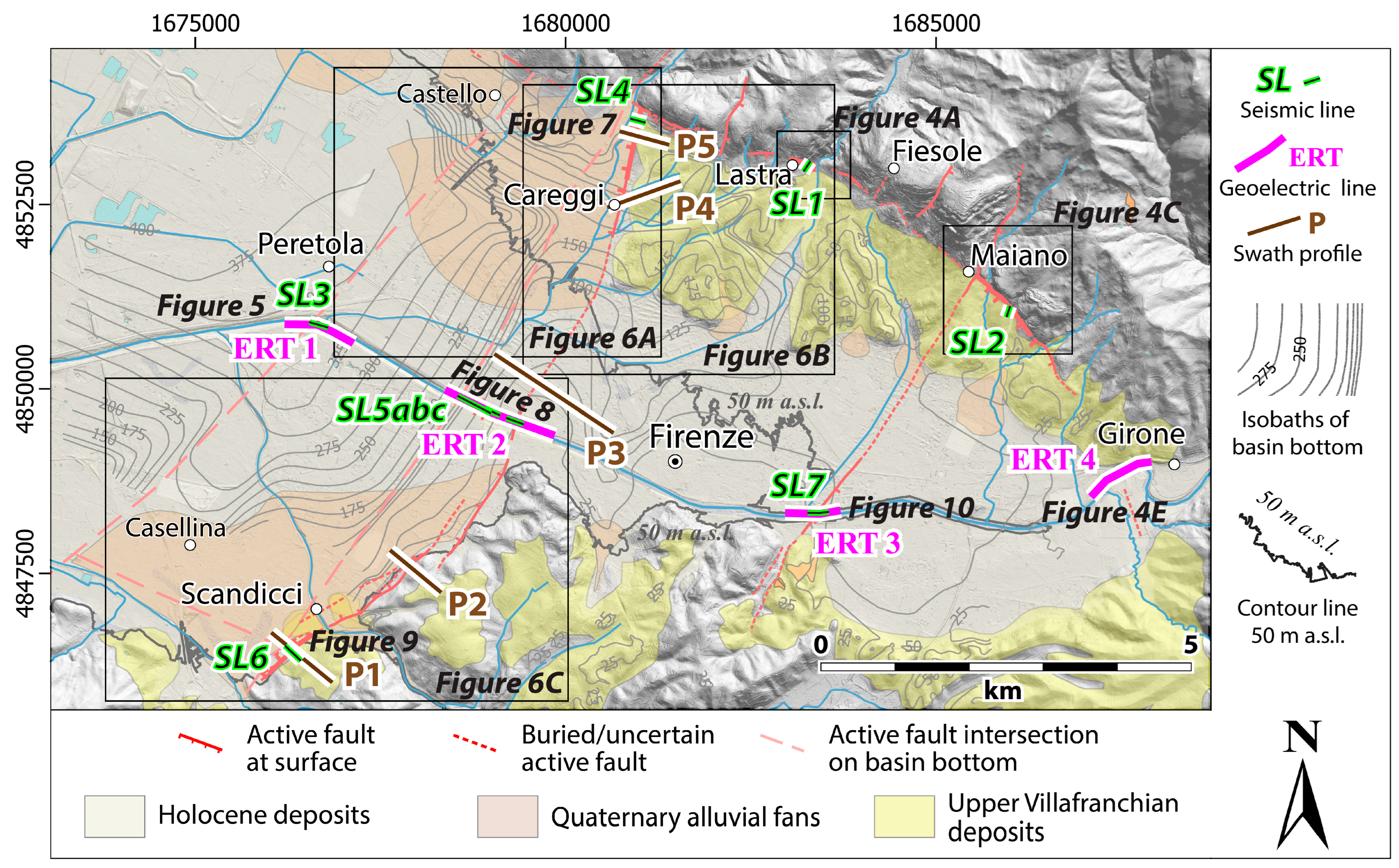
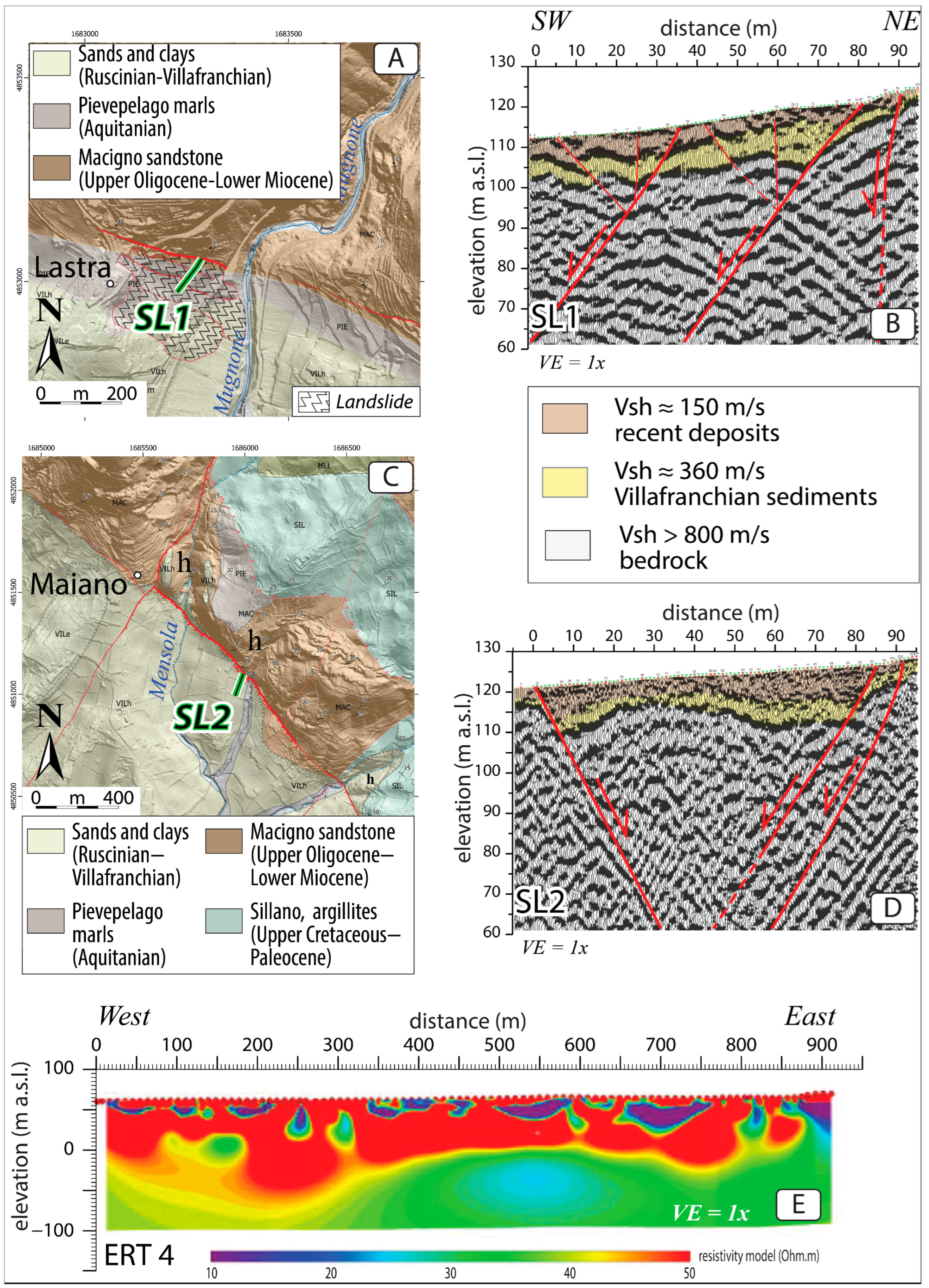
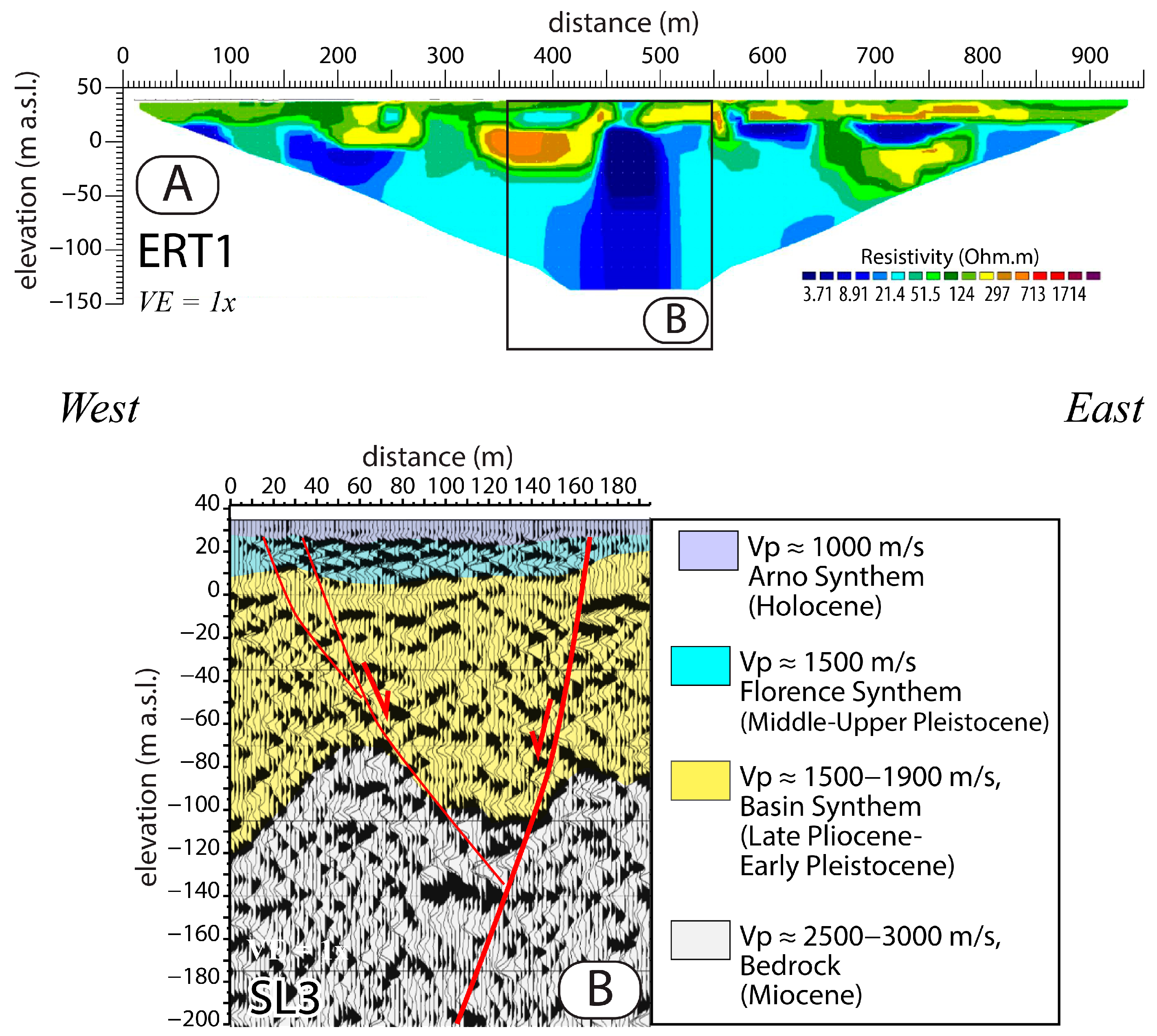
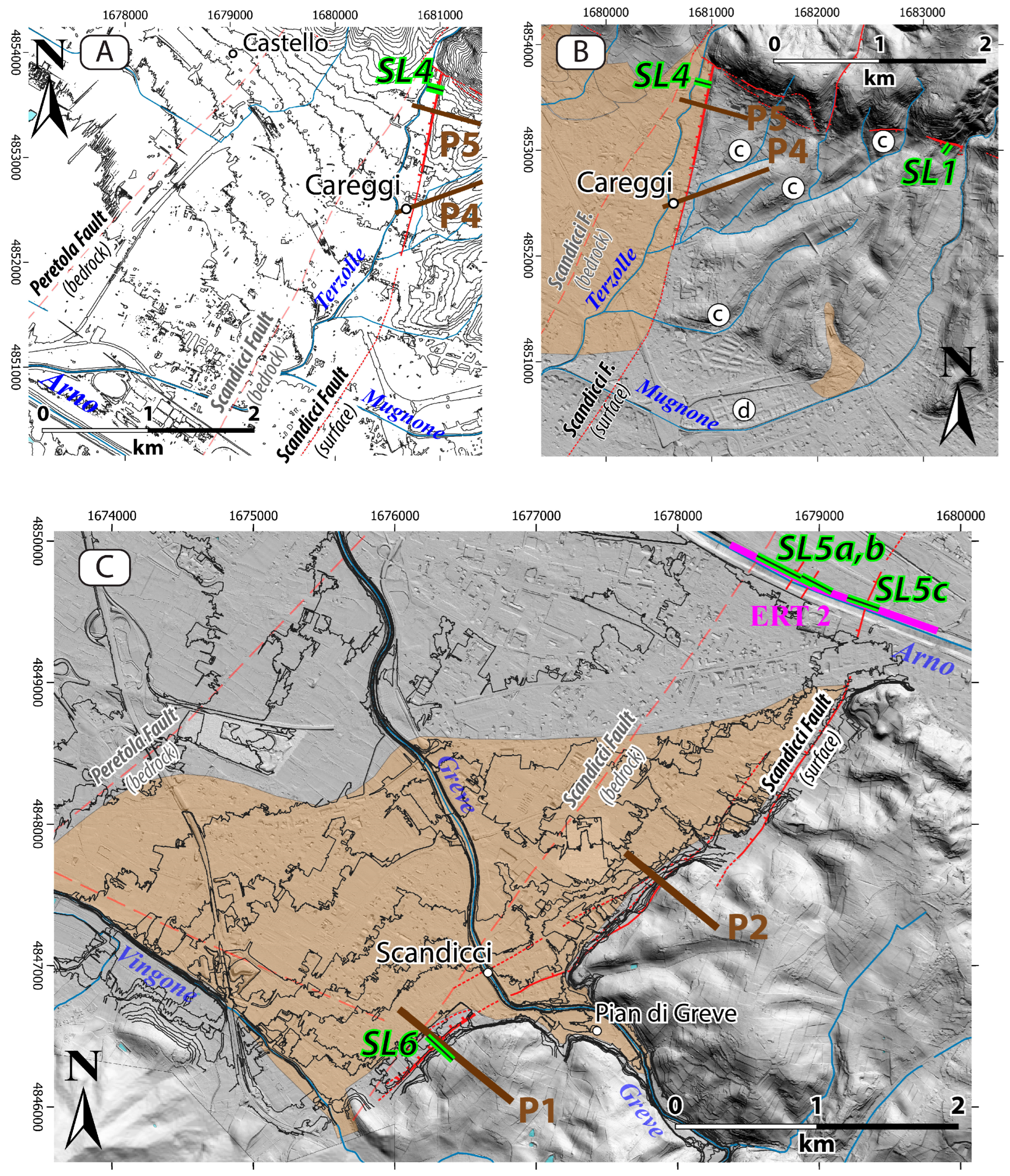
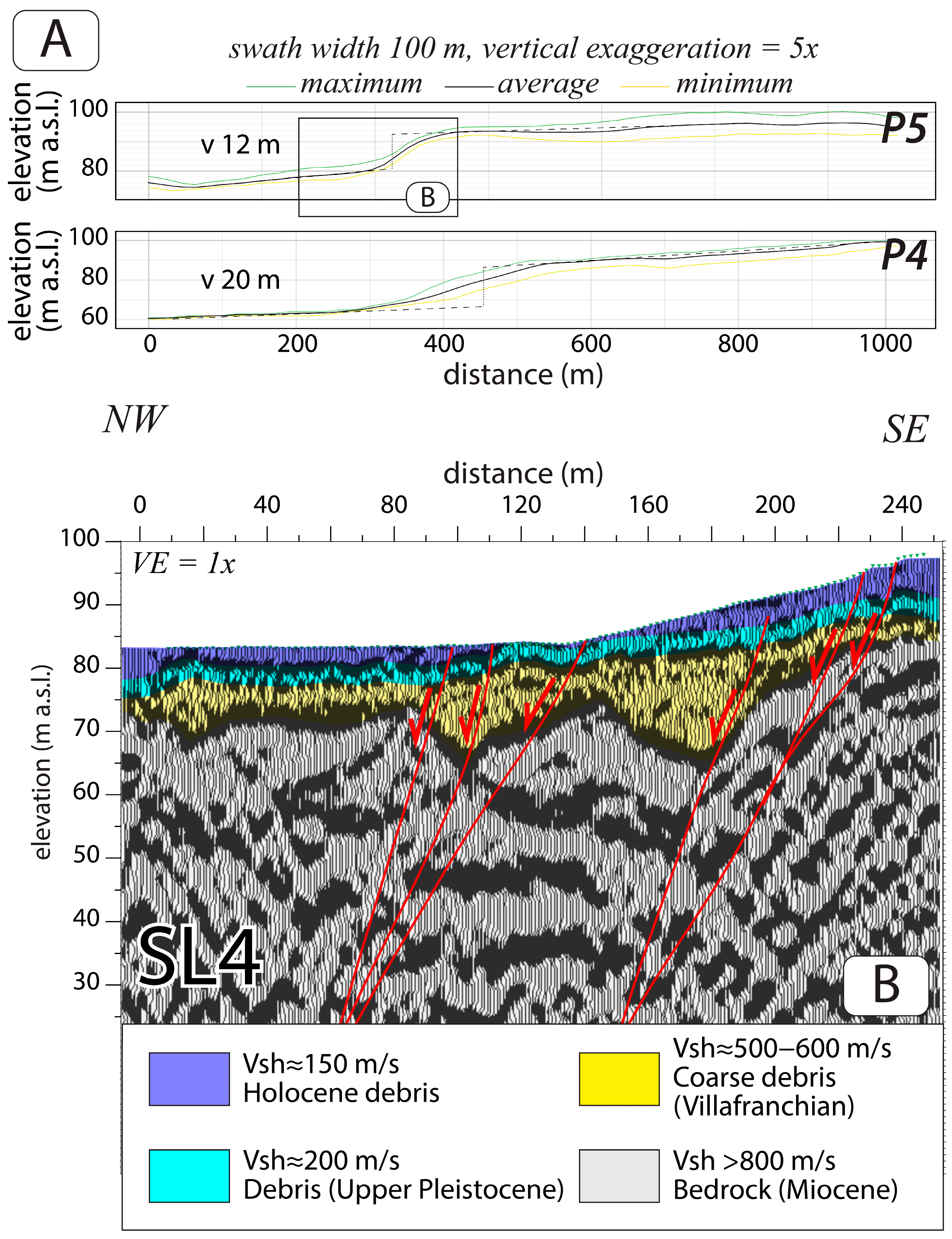

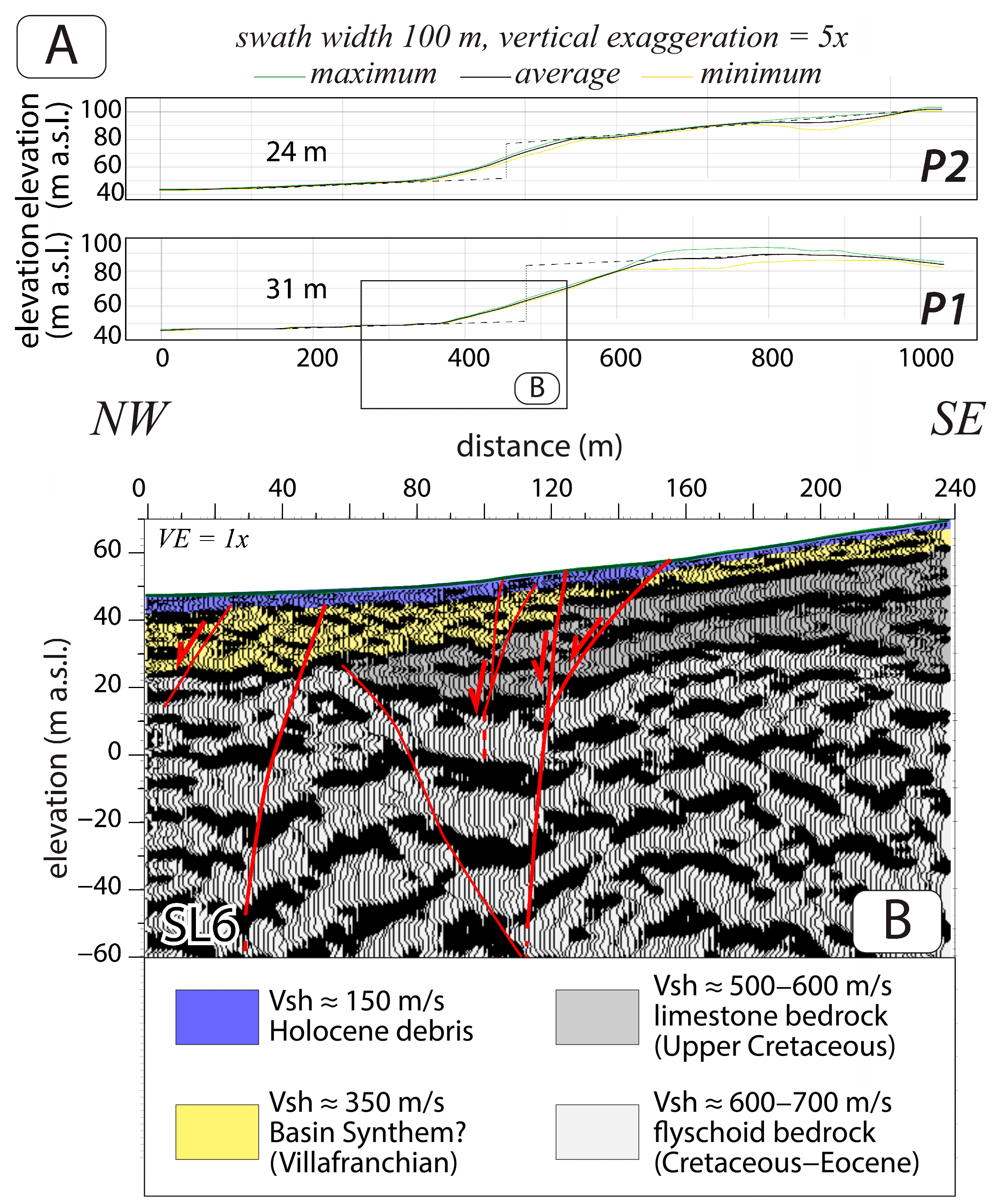
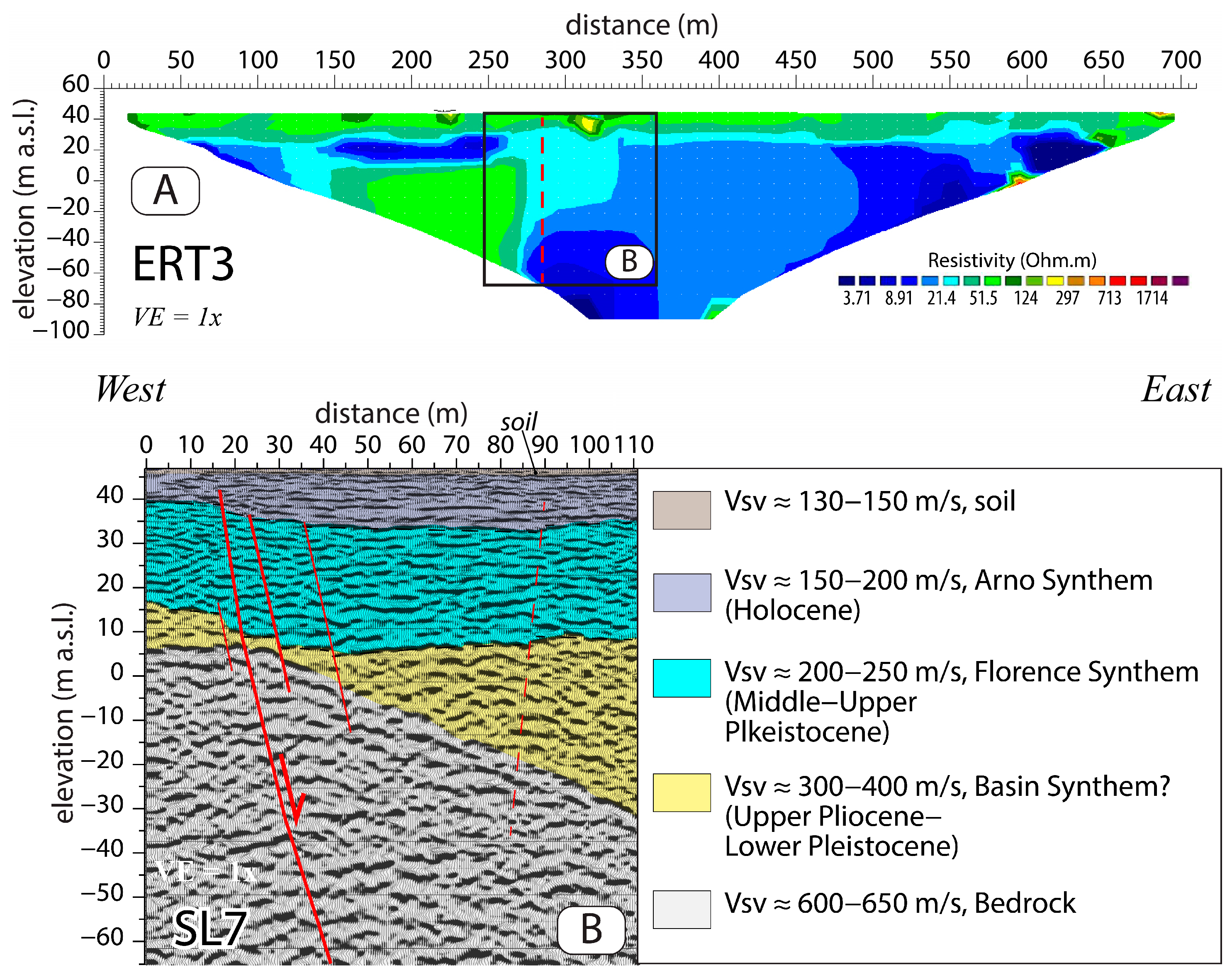
| Code | Longitude Start | Latitude Start | Longitude End | Latitude End |
|---|---|---|---|---|
| Figure 2B | 11.0225 | 43.8934 | 11.2644 | 43.7756 |
| P1 | 11.1862 | 43.7522 | 11.1958 | 43.7461 |
| P2 | 11.2064 | 43.7618 | 11.2142 | 43.7569 |
| P3 | 11.2247 | 43.7855 | 11.2441 | 43.7756 |
| P4 | 11.2445 | 43.8031 | 11.2564 | 43.8059 |
| P5 | 11.2468 | 43.8122 | 11.2546 | 43.8104 |
| Code | Long/Lat Start | Long/Lat End | Length (m) | Depth (m) | Geophones Distance Shot Dist. # Geoph. /Electrodes | Waves | Multifold % | Method |
|---|---|---|---|---|---|---|---|---|
| SL1 | 11.2776 43.8070 | 11.2783 43.8077 | 100 | 70 | 1 m | transv. | 4800 | PDM and WM |
| 1 m | ||||||||
| 96 | ||||||||
| SL2 | 11.3108 43.7886 | 11.3113 43.7894 | 105 | 80 | 1 m | transv. | 4800 | PDM and WM |
| 1 m | ||||||||
| 96 | ||||||||
| SL3 | 11.1941 43.7899 | 11.1966 43.7893 | 190 | 440 | 2 m | compr. | 2400 | PDM and WM |
| 2 m | ||||||||
| 96 | ||||||||
| SL4 | 11.2488 43.8137 | 11.2504 43.8134 | 119 | 80 | 1 m | transv. | 3000 | PDM and WM |
| 2 m | ||||||||
| 120 | ||||||||
| SL5a | 11.2187 43.7804 | 11.2239 43.7784 | 475 | 440 | 5 m | compr. | 1600 | PDM and WM |
| 15 m | ||||||||
| 96 | ||||||||
| Sl5b | 11.2219 43.7792 | 11.2250 43.7780 | 285 | 440 | 3 m | compr. | 4800 | PDM and WM |
| 3 m | ||||||||
| 96 | ||||||||
| SL5c | 11.2265 43.7776 | 11.2291 43.7769 | 190 | 2 m | compr. | 2400 | PDM and WM | |
| 2 m | ||||||||
| 96 | ||||||||
| SL6 | 11.1886 43.7504 | 11.1907 43.7489 | 240 | 170 | 3 m | transv. | 2000 | PDM and WM |
| 6 m | ||||||||
| 80 | ||||||||
| SL7 | 11.2768 43.7651 | 11.2797 43.7651 | 119 | 120 | 1 m | compr. | 6000 | PDM and WM |
| 2 m | ||||||||
| 120 | ||||||||
| ERT 1 | 11.1900 43.7898 | 11.2009 43.7874 | 950 | 140 | 10 m | SDCA | ||
| 96 | ||||||||
| ERT 2 | 11.2164 43.7812 | 11.2342 43.7755 | 1575 | 140 | 10 m 156 | SDCA | ||
| ERT 3 | 11.2729 43.7651 | 11.2816 43.7653 | 710 | 100 | 10 m | Array Wenner | ||
| 72 | ||||||||
| ERT 4 | 11.3242 43.7662 | 11.3341 43.7702 | 950 | 140 | 10 m | Array Wenner | ||
| 96 |
| Energiser | 1250 gr. Instrumented Hammer 10 kg Seismic Hammer 35 kg Hammer | Signal Generation |
|---|---|---|
| Horizontal geophones | 3.4 kOhm 4.5 Hz | Conversion of seismic signal into electrical signal |
| Vertical geophones | 4 kOhm 100 Hz | Conversion of seismic signal into electrical signal |
| SARA Do.Re.Mi. seismograph | Digitizers—24 bit | A/D signal conversion and registration |
Disclaimer/Publisher’s Note: The statements, opinions and data contained in all publications are solely those of the individual author(s) and contributor(s) and not of MDPI and/or the editor(s). MDPI and/or the editor(s) disclaim responsibility for any injury to people or property resulting from any ideas, methods, instructions or products referred to in the content. |
© 2025 by the authors. Licensee MDPI, Basel, Switzerland. This article is an open access article distributed under the terms and conditions of the Creative Commons Attribution (CC BY) license (https://creativecommons.org/licenses/by/4.0/).
Share and Cite
Piccardi, L.; D’Alessandro, A.; Vittori, E.; D’Intinosante, V.; Baglione, M. An Integrated Remote Sensing and Near-Surface Geophysical Approach to Detect and Characterize Active and Capable Faults in the Urban Area of Florence (Italy). Remote Sens. 2025, 17, 2644. https://doi.org/10.3390/rs17152644
Piccardi L, D’Alessandro A, Vittori E, D’Intinosante V, Baglione M. An Integrated Remote Sensing and Near-Surface Geophysical Approach to Detect and Characterize Active and Capable Faults in the Urban Area of Florence (Italy). Remote Sensing. 2025; 17(15):2644. https://doi.org/10.3390/rs17152644
Chicago/Turabian StylePiccardi, Luigi, Antonello D’Alessandro, Eutizio Vittori, Vittorio D’Intinosante, and Massimo Baglione. 2025. "An Integrated Remote Sensing and Near-Surface Geophysical Approach to Detect and Characterize Active and Capable Faults in the Urban Area of Florence (Italy)" Remote Sensing 17, no. 15: 2644. https://doi.org/10.3390/rs17152644
APA StylePiccardi, L., D’Alessandro, A., Vittori, E., D’Intinosante, V., & Baglione, M. (2025). An Integrated Remote Sensing and Near-Surface Geophysical Approach to Detect and Characterize Active and Capable Faults in the Urban Area of Florence (Italy). Remote Sensing, 17(15), 2644. https://doi.org/10.3390/rs17152644








